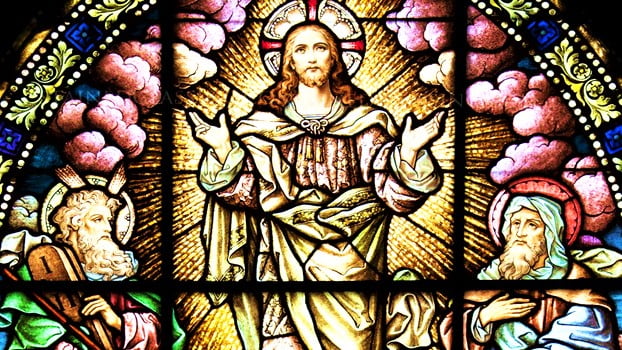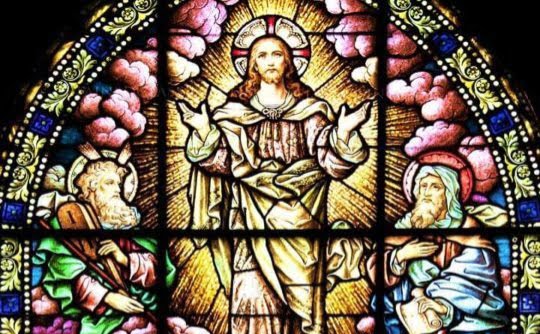Pope Francis on the TRANSFIGURATION OF OUR LORD.

HOMILY OF HIS HOLINESS
“Parque Tejo” (Lisbon)
Feast of the Transfiguration of the Lord
Sunday, 6 August 2023
________________________________________
After these exciting days, surely we feel like repeating the words of the Apostle Peter on the mount of the Transfiguration: “Lord, it is good for us to be here!” (Mt 17:4). Indeed, how good it has been to share this experience with Jesus, with one another, and to pray together with joyful hearts. Now, we can also ask an important question: What will we take back with us as we resume our daily lives?
I would like to answer this question with three verbs, drawing from the Gospel we have heard: to shine, to listen, and to be unafraid. What will we take back with us? I would respond with these three words: to shine, to listen, and to be unafraid
The first: to shine. Jesus is transfigured. The Gospel tells us: “his face shone like the sun” (Mt 17:2). Shortly before this, he had predicted his passion and death on the cross, shattering the disciples’ image of a powerful and worldly Messiah, and disappointing their expectations. Now, in order to help them embrace the loving plan that God has for each of us, Jesus takes three of the disciples, Peter, James, and John, and leads them up the mountain, where he is transfigured. Through this brilliant burst of light, Jesus prepares the disciples for the dark night of the Passion.
Dear young friends, today we too need something of this burst of light, so that it can fill us with hope as we face the many failures of each day and the darkness that assails us in life, and respond to them with the light of the resurrection of Jesus. For he is the light that never sets, the light that shines even in the dead of night. As the priest Ezra said, God has illumined our eyes (cf Ezra 9:8). Our God illumines: he illumines our vision, our hearts, our minds, our desire to do something with our lives. The Lord’s light always shines.
Yet, I would like to tell you that we do not radiate light by putting ourselves in the spotlight, for that type of light is blinding. No, we cannot illumine others by projecting a perfect, well-ordered, refined image of ourselves, or by appearing to be powerful and successful, strong but without light. No, we radiate light – we shine – by welcoming Jesus into our hearts and learning to love as he does. To love like Jesus: that is what makes us shine, makes us do works of love. Friends, I am telling you the truth: whenever you do works of love, you become light. But the moment you stop loving others and become self-centered, you extinguish your light.
The second verb is to listen. On the mountain, a bright cloud overshadows the disciples. And what does it tell us, this cloud from which the Father speaks? “This is my Son, the Beloved… listen to him!” (Mt 17:5). Listen to him. To listen to Jesus, that is life’s secret. Listen to what Jesus is saying to you. “But I don’t know what he is saying to me”. Well, take the Gospels and read there what Jesus is saying, what he is saying to your heart. For he has the words of eternal life for us, he reveals that God is our Father, that God is love. He shows us the way of love. Listen to Jesus; otherwise, even if we set out with good intentions along paths that seem to be of love, in the end those paths will be seen as selfishness disguised as love. Be careful of selfishness disguised as love! Listen to Jesus, for he will show you which paths are those of love. Listen to him.
The first word: to shine, so be radiant; then, listen in order not to take the wrong path; finally the third word: to be unafraid. Do not be afraid. We often find these words in the Bible, in the Gospels: “Do not be afraid”. These were the last words spoken by Jesus to the disciples at the moment of the Transfiguration: “Do not be afraid!” (Mt 17:7).
As young people, you have experienced these days of joy – I was about to say of glory, and indeed our encounters have been a kind of glory. You have great dreams, but often fear that they may not come true; sometimes you think that you are not up to the challenge, which is a kind of pessimism that can overcome us at times. As young people, you may be tempted at this time to lose heart, to think you fall short, or to disguise your pain with a smile. As young people, you want to change the world – and it is very good that you want to change the world – you want to work for justice and peace. You devote all your life’s energy and creativity to this, but it still seems insufficient. Yet, the Church and the world need you, the young, as much as the earth needs rain. To all of you, dear young people, who are the present and the future, yes to all of you, Jesus now says: “Have no fear”, “Do not be afraid!”.
Now, in a brief moment of silence, each of you repeat these words, in your own heart: “Do not be afraid!”
Dear young people, I would like to look into the eyes of each of you and say: Do not be afraid. I will tell you something else, also very beautiful: it is no longer I, but Jesus himself who is now looking at you. He knows each of your hearts, each of your lives; he knows your joys, your sorrows, your successes and failures. He knows your heart. Today, he says to you, here in Lisbon, at this World Youth Day: “Have no fear, take heart, do not be afraid!”.
Source: https://www.vatican.va/content/francesco/en/homilies/2023/documents/20230806-portogallo-omelia-gmg.html
Copyright © Dicastero per la Comunicazione – Libreria Editrice Vaticana
EMPHASIS MINE
Dear Brothers and Sisters, Good morning!
On this Second Sunday of Lent, the liturgy leads us to contemplate the event of the Transfiguration in which Jesus allows the disciples Peter, James and John a foretaste of the glory of the Resurrection: a glimpse of heaven on earth. Luke the Evangelist (cf. 9:28-36) reveals to us Jesus transfigured on the mountain, which is the place of light, a fascinating symbol of the unique experience reserved to the three disciples. They go up the mountain with the Master, they see him immersed in prayer and, at a certain point, “the appearance of his countenance was altered” (v. 29). Accustomed to seeing him daily in the simple appearance of his humanity, they are astonished as they face that new splendour that also envelops his entire body. And Moses and Elijah appear beside Jesus and speak with Him about his forthcoming “exodus”, that is, of his Paschal death and Resurrection. It is a preview of Easter. Then Peter exclaims: “Master, it is well that we are here” (v. 33). He wished that that moment of grace would never end!
The Transfiguration occurs at a precise moment in Christ’s mission, that is, after he has confided to his disciples that he would have to “suffer many things, […] be killed, and on the third day be raised” (v. 21). Jesus knows that they do not accept this reality — the reality of the Cross, the reality of Jesus’ death —, and so he wants to prepare them to withstand the scandal of the passion and death on the Cross, so that they may know that this is the way through which the heavenly Father will lead his Son to glory; by raising him from the dead. And this will also be the way for the disciples: no one can reach eternal life if not by following Jesus, carrying their own cross in their earthly life. Each of us has his or her own cross. The Lord reveals to us the end of this journey which is the Resurrection, beauty: by carrying one’s own cross.
Therefore, the Transfiguration of Christ shows us the Christian perspective of suffering. Suffering is not sadomasochism: it is a necessary but transitory passage. The point of arrival to which we are called is luminous like the face of Christ Transfigured: in him is salvation, beatitude, light and the boundless love of God. By revealing his glory in this way, Jesus ensures that the cross, the trials, the difficulties with which we struggle, are resolved and overcome in Easter. Thus this Lent, let us also go up the mountain with Jesus! But in what way? With prayer. Let us climb the mountain with prayer: silent prayer, heartfelt prayer, prayer that always seeks the Lord. Let us pause for some time in reflection, a little each day, let us fix our inner gaze on his countenance and let us allow his light to permeate us and shine in our life.
Indeed, Luke the Evangelist emphasizes the fact that Jesus was transfigured, “as he was praying” (v. 29). He was immersed in an intimate dialogue with the Father in which the Law and the Prophets — Moses and Elijah — also echoed; and as he adhered with his entire being to the Father’s will of salvation, including the Cross, the glory of God flooded him, even shining on the outside. This is how it is, brothers and sisters: prayer in Christ and in the Holy Spirit transforms the person from the inside and can illuminate others and the surrounding world. How often have we found people who illuminate, who exude light from their eyes, who have that luminous gaze! They pray, and prayer does this: it makes us luminous with the light of the Holy Spirit.
Let us joyfully continue our Lenten journey. Let us make room for prayer and for the Word of God which the liturgy abundantly offers us these days. May the Virgin Mary teach us to abide with Christ even when we do not understand or comprehend him because only by abiding with him will we see his glory.
SOURCE: March 17, 2019, Angelus address http://w2.vatican.va/content/francesco/en/angelus/2019/documents/papa-francesco_angelus_20190317.html
EMPHASIS MINE.

